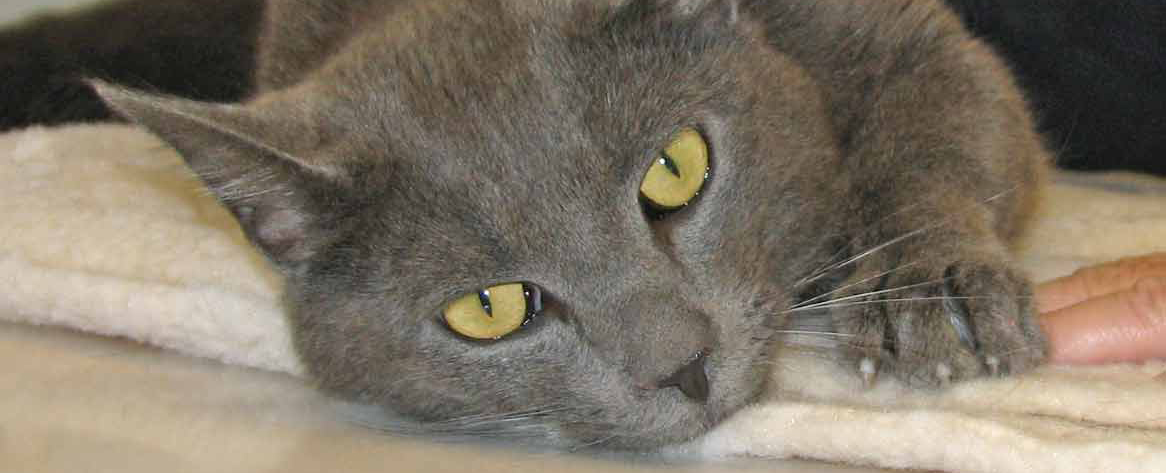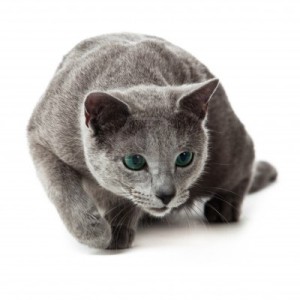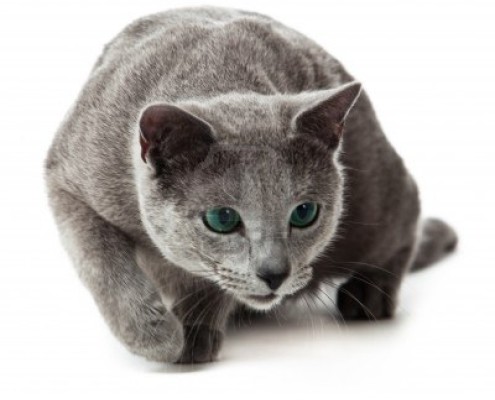Russian Blue

Meoww!!
A cat of Foreign type, slender but not overly lean, with a fairly long face and large ears -although nowhere near the head and ear shape of an Oriental or Siamese.
In 5 Words
- Sensitive
- Quiet
- Shy
- Reserved
- Loyal
Snapshot
Size (Weight): 10-14 lbs
Origin: Russia
Color: Blue
Personality: Well-behaved and Playful
Ideal Parents: Singles, Families, City Dwellers
Energy: Active
Talkative: Little
Coat: Short
Kid Friendly: Yes
Less Allergenic: No
Lifespan: 15-20 years

Characteristics
Learn About the Russian Blue
It is believed that sailors took Russian Blues from the Archangel Isles to England and Northern Europe in the 1860s. The first recorded appearance outside of Russia was in 1875 at the Crystal Palace in England, as the Archangel Cat. Another legend states that the Russian Blue is a descendant of the royal cats owned by the Russian Czars. Although several Russian Blue fanciers are actively searching for historical information, little is known about the Russian Blue in the early part of the 20th century. These striking blue cats are reputed to have been brought to England and to Northern Europe as trading goods by sailors on merchant ships that departed from or near the White Sea port of Arkhangelsk (or Archangel) sometime in the mid-1800s. The origin of the Russian Blue is very vague. This vagueness you will also find in the many names this breed has had. Spanish Blue, Maltese Blue, Foreign Blue and Archangels Blue are only some of these names.
A cat of Foreign type, slender but not overly lean, with a fairly long face and large ears -although nowhere near the head and ear shape of an Oriental or Siamese. The coat is short and dense but not sleek; it should rather be as thick as to slightly stand out from the body.
The aristocratic Russian Blue is the gem of the feline world. The Russian Blue is a medium to large cat with an elegant, graceful body. The head is wedged shaped and is short from the tip of the nose to the eyes. The shallow concave curve from the upper eye to the tip of the nose appears almost straight and creates a distinctive angle level with the upper eye. The Russian Blue is a powerful cat with a long, well muscled body and graceful carriage. The breed can appear heavy because of the plushness of their fur.
Russian Blue cats are quiet and sensitive, sometimes shy and reserved but are also tremendously loyal to their chosen human being. Once settled in a loving environment they love to play with toys and enjoy jumping, climbing and racing around and are extremely agile and light footed. They love human attention and can appear to be quite hurt when rejected. Russian Blues are quite content to be house cats as long as they have the company of their human friends.
This is a well-behaved cat that is easy to train. Or, rather, it easily trains its people. It enjoys a good game of fetch and will keep the game going longer than you may have time for, and you will make time because the Russian Blue is known for actually appearing hurt when it has been ignored.
As a natural breed Russian Blues have few, if any, inherent problems. Genetic disorders or temperament problems in this breed come back to poor breeding practices, not the breed itself. There are very few health problem associated with this breed, although some owners report overeating, especially of dry cat food, which can cause vomiting.
Please do vaccinate your cat and as veterinary fees are expensive, you should always consider medical cat insurance for your pet. Russian Blue cats are easy to care for, in fact, less frequent grooming results in the coat having a deeper sheen whilst over-grooming can damage the coat.
The special coat of the Russian Blue has relatively little care. It is sufficient to occasionally brush the coat with a soft brush. Daily dental hygiene is best, but weekly brushing is better than nothing.






